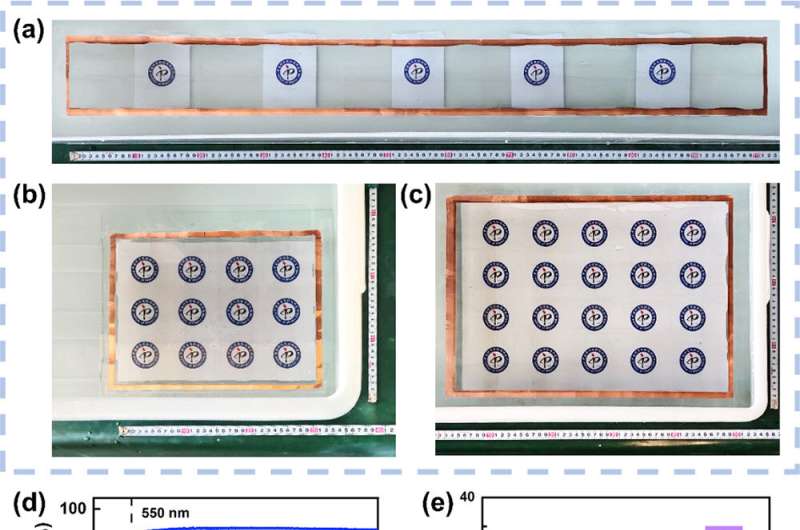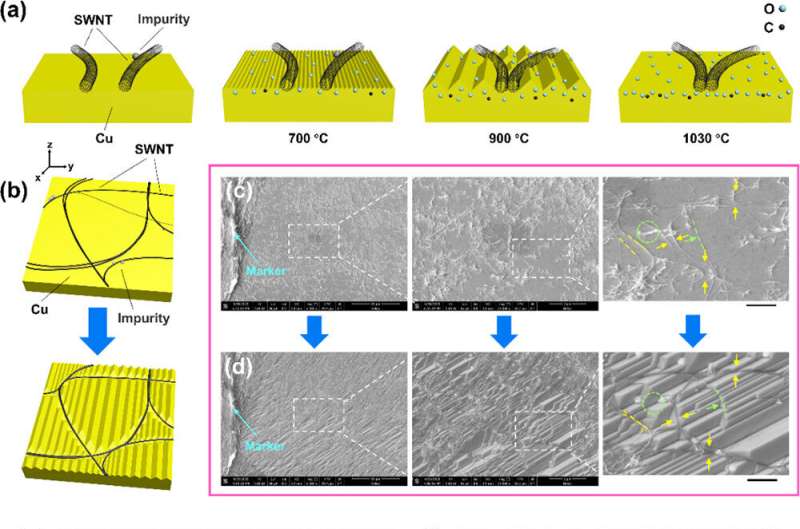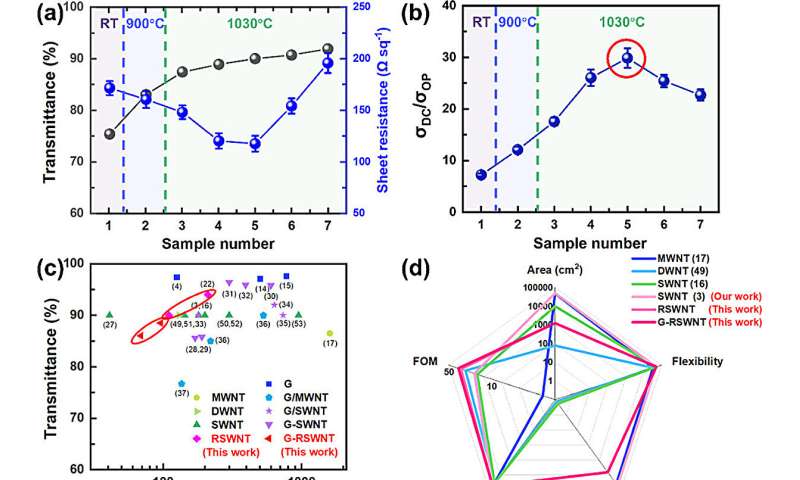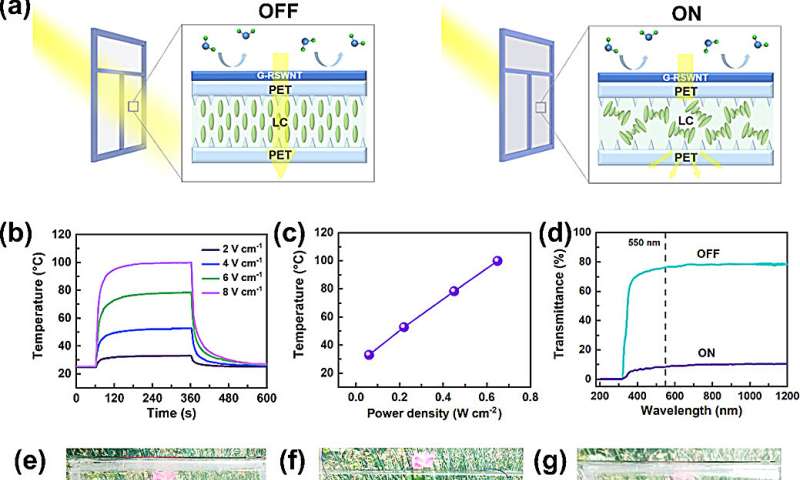This article has been reviewed according to Science X's editorial process and policies. Editors have highlighted the following attributes while ensuring the content's credibility:
fact-checked
trusted source
proofread
Large-area preparation of flexible carbon nanofilms with synergistically enhanced transmittance and conductivity

Large-area flexible transparent conductive films (TCFs) are urgently needed for future electronics, optoelectronics, energy devices and other fields. Indium tin oxide (ITO) TCF, which is widely used in modern technology, faces difficulties in meeting the needs of scientific and technological development (especially a new generation of flexible electronic devices) because indium is a non-renewable resource and expensive, and ITO is inherently brittle.
Currently, carbon nanofilms, metal nanowires, conductive polymers, and other transparent conductive materials have been developed to replace ITO. Among them, a carbon nanofilm is considered to be one of the most promising candidates due to its excellent electrical and optical properties, flexibility, and excellent stability, as well as lightweight, radiation resistance, and ultra-fatigue resistance which are particularly needed in future aerospace and military applications.
However, in order to realize the widespread application of flexible TCFs, it is not only necessary to overcome the mutual restriction between transmittance and conductivity, but also to be able to fabricate them on a large area or even on a large scale. This is a knotty problem that has puzzled researchers in the field of carbon nanomaterials and even in the field of TCFs for many years.
Researchers from the Institute of Physics of the Chinese Academy of Sciences have been engaged in the fundamental investigation of the preparation, properties and potential applications of low-dimensional carbon nanomaterials and nanostructures for more than 30 years, and have achieved a series of innovative and important results.
The study, titled "Large-Area Flexible Carbon Nanofilms with Synergistically Enhanced Transmittance and Conductivity Prepared by Reorganizing Single-Walled Carbon Nanotube Networks," was published in Advanced Materials.

Based on their developed freestanding transparent conductive carbon nanotube film (CNT TCF) continuously and directly prepared by the blowing aerosol method, in view of the above challenging problems, Yue Ying, a Ph.D. candidate, under the supervision of Prof. Zhou Weiya, proposed an advanced carbon nanotube network reorganization (CNNR) strategy, designed and developed an innovative facet-driven CNNR (FD-CNNR) technique, broke through the bottleneck of mutual restriction between the key properties of carbon nanofilms, and achieved the large-area fabrication and lossless transfer of CNT films.
It provides an effective scheme to solve the problem of large-area flexible TCFs.
Based on the unique mechanism of the FD-CNNR technique, the researchers introduced an interaction between single-walled carbon nanotube (SWNT) and Cu-O reconfiguration for the first time, which allows the SWNT network to reorganize into a more efficient conductive path.
Using this technique, large-area, flexible and freestanding reorganized carbon nanotube TCFs (RNC-TCFs) with A3 size or even meter-length were designed and prepared, including the reorganized SWNT (RSWNT) film and the hybrid film of graphene and reorganized SWNT (G-RSWNT), the latter has an area of more than 1,200 times that of the existing freestanding hybrid films reported.
Moreover, the FD-CNNR technique enables these lightweight films to exhibit excellent flexibility, with synergistically enhanced high mechanical strength, outstanding transmittance and conductivity, and significant FOM values. The prepared large-area RNC-TCFs can be freestanding on the water surface and can be transferred to other target substrates without contamination and damage.
-

(a,b) Parameter optimization of SWNT reorganization process. (c) Comparison of sheet resistance and transmittance of the present work with other reported carbon nanofilms. (d) Comparison of multiple properties of the present work with other reported carbon nanofilms. (e) Photographs of G-RSWNT TCF with A3 size and 1m×10cm transferred to PET substrate. Credit: Institute of Physics -

(a) Schematic structure and principle of flexible smart window based on G-RSWNT film and liquid crystal layer. (b) Temperature variation of the smart window at different voltage densities. (c) The required power density of the smart window at different steady state temperatures. (d) Transmittance of the smart window in ON/OFF state. (e,f) Transparency change of smart window by voltage regulation at room temperature 25°C, spreading and bending states. (g) Defogging test at 20°C with smart window operating temperature of 28°C. Credit: Institute of Physics
Based on a large-area G-RSWNT TCF and a liquid crystal layer, a new A4-size flexible smart window with multi-functions such as fast heating, controllable dimming and defogging was fabricated. The FD-CNNR technique can not only be extended to large-area or even large-scale preparation of TCFs, but also provide a new idea for the design of TCFs and other functional films.
This work makes up for the shortcomings of the research in the field of large-area graphene-carbon nanotube hybrid films, and is expected to promote the large-scale preparation of large-area, flexible, freestanding, lightweight, and transparent conductive carbon nanofilms and their future applications in the fields of flexible electronics, photovoltaic devices, optical engineering, artificial intelligence, advanced architecture, transportation, and even aerospace, etc.
More information: Ying Yue et al, Large‐Area Flexible Carbon Nanofilms with Synergistically Enhanced Transmittance and Conductivity Prepared by Reorganizing Single‐Walled Carbon Nanotube Networks, Advanced Materials (2024). DOI: 10.1002/adma.202313971
Provided by Chinese Academy of Sciences





















